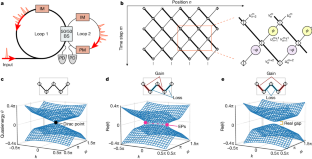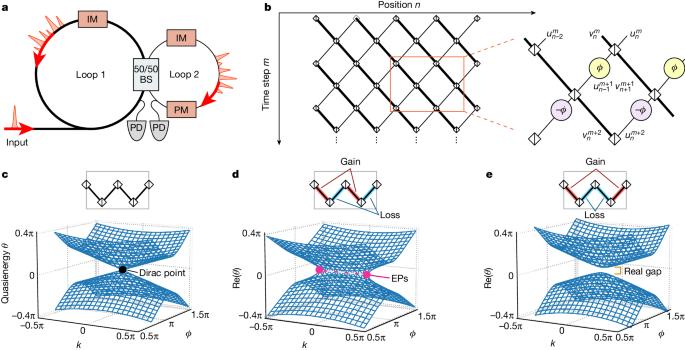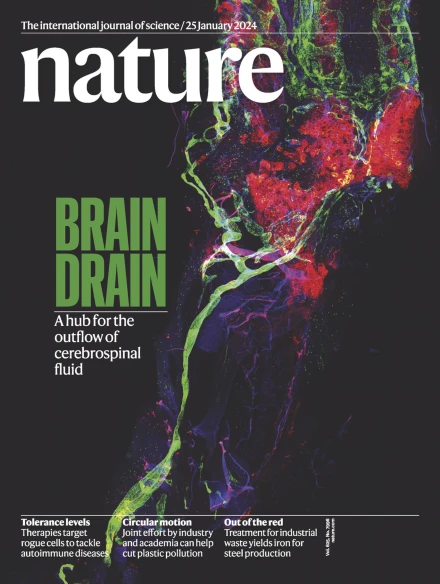由光学增益和损耗引起的狄拉克质量
IF 50.5
1区 综合性期刊
Q1 MULTIDISCIPLINARY SCIENCES
引用次数: 0
摘要
质量通常被认为是物质的固有属性,但现代物理学揭示了粒子质量的复杂来源1,如高能物理中的希格斯机制2,3。在石墨烯等晶格中,相对论狄拉克粒子可以作为低能准粒子4 存在,其质量由打破晶格对称性的扰动5-8 所赋予。这些质量产生机制都假定了赫尔墨斯性(Hermiticity)或详细的能量守恒。我们使用光子合成晶格,通过实验证明,基于光学增益和损耗的非赫米提扰动可以产生狄拉克质量。然后,我们探讨了增益和损耗引起的狄拉克质量的时空工程如何影响准粒子。正如我们所展示的,准粒子在空间边界会发生克莱因隧穿,但非赫米提对称性的局部破缺会在畴壁产生新的通量非守恒效应。在突然改变狄拉克质量符号的时间边界上,我们观察到时间反射现象的一种变体:在非相对论极限下,狄拉克准粒子的速度发生逆转,而在相对论极限下,原来的速度保持不变。本文章由计算机程序翻译,如有差异,请以英文原文为准。


Dirac mass induced by optical gain and loss
Mass is commonly considered an intrinsic property of matter, but modern physics reveals particle masses to have complex origins1, such as the Higgs mechanism in high-energy physics2,3. In crystal lattices such as graphene, relativistic Dirac particles can exist as low-energy quasiparticles4 with masses imparted by lattice symmetry-breaking perturbations5–8. These mass-generating mechanisms all assume Hermiticity, or the conservation of energy in detail. Using a photonic synthetic lattice, we show experimentally that Dirac masses can be generated by means of non-Hermitian perturbations based on optical gain and loss. We then explore how the spacetime engineering of the gain and loss-induced Dirac mass affects the quasiparticles. As we show, the quasiparticles undergo Klein tunnelling at spatial boundaries, but a local breaking of a non-Hermitian symmetry can produce a new flux non-conservation effect at the domain walls. At a temporal boundary that abruptly flips the sign of the Dirac mass, we observe a variant of the time-reflection phenomenon: in the non-relativistic limit, the Dirac quasiparticle reverses its velocity, whereas in the relativistic limit, the original velocity is retained. By using a photonic synthetic lattice, it can be experimentally demonstrated that Dirac masses can be induced by means of non-Hermitian perturbations based on optical gain and loss.
求助全文
通过发布文献求助,成功后即可免费获取论文全文。
去求助
来源期刊

Nature
综合性期刊-综合性期刊
CiteScore
90.00
自引率
1.20%
发文量
3652
审稿时长
3 months
期刊介绍:
Nature is a prestigious international journal that publishes peer-reviewed research in various scientific and technological fields. The selection of articles is based on criteria such as originality, importance, interdisciplinary relevance, timeliness, accessibility, elegance, and surprising conclusions. In addition to showcasing significant scientific advances, Nature delivers rapid, authoritative, insightful news, and interpretation of current and upcoming trends impacting science, scientists, and the broader public. The journal serves a dual purpose: firstly, to promptly share noteworthy scientific advances and foster discussions among scientists, and secondly, to ensure the swift dissemination of scientific results globally, emphasizing their significance for knowledge, culture, and daily life.
 求助内容:
求助内容: 应助结果提醒方式:
应助结果提醒方式:


